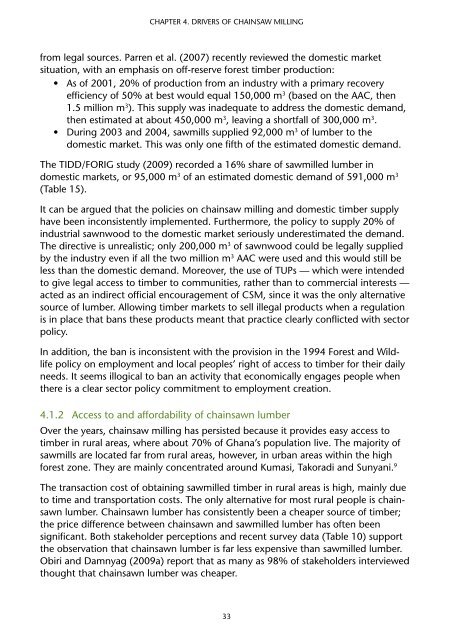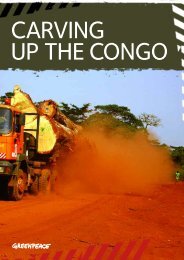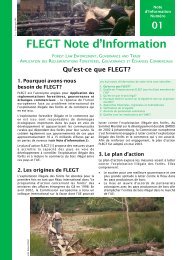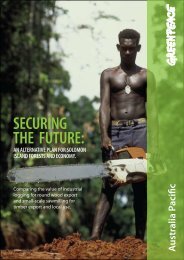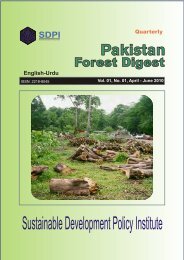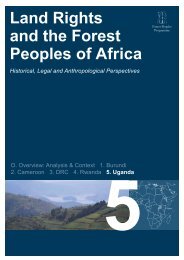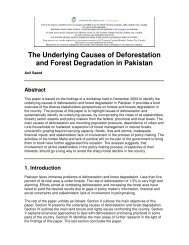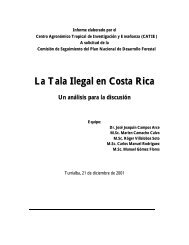CHAINSAW MILLING IN GHANA: CONTExT, DRIVERS ... - Fornis.net
CHAINSAW MILLING IN GHANA: CONTExT, DRIVERS ... - Fornis.net
CHAINSAW MILLING IN GHANA: CONTExT, DRIVERS ... - Fornis.net
- No tags were found...
Create successful ePaper yourself
Turn your PDF publications into a flip-book with our unique Google optimized e-Paper software.
Chapter 4. Drivers of chainsaw millingfrom legal sources. Parren et al. (2007) recently reviewed the domestic marketsituation, with an emphasis on off-reserve forest timber production:• As of 2001, 20% of production from an industry with a primary recoveryefficiency of 50% at best would equal 150,000 m 3 (based on the AAC, then1.5 million m 3 ). This supply was inadequate to address the domestic demand,then estimated at about 450,000 m 3 , leaving a shortfall of 300,000 m 3 .• During 2003 and 2004, sawmills supplied 92,000 m 3 of lumber to thedomestic market. This was only one fifth of the estimated domestic demand.The TIDD/FORIG study (2009) recorded a 16% share of sawmilled lumber indomestic markets, or 95,000 m 3 of an estimated domestic demand of 591,000 m 3(Table 15).It can be argued that the policies on chainsaw milling and domestic timber supplyhave been inconsistently implemented. Furthermore, the policy to supply 20% ofindustrial sawnwood to the domestic market seriously underestimated the demand.The directive is unrealistic; only 200,000 m 3 of sawnwood could be legally suppliedby the industry even if all the two million m 3 AAC were used and this would still beless than the domestic demand. Moreover, the use of TUPs — which were intendedto give legal access to timber to communities, rather than to commercial interests —acted as an indirect official encouragement of CSM, since it was the only alternativesource of lumber. Allowing timber markets to sell illegal products when a regulationis in place that bans these products meant that practice clearly conflicted with sectorpolicy.In addition, the ban is inconsistent with the provision in the 1994 Forest and Wildlifepolicy on employment and local peoples’ right of access to timber for their dailyneeds. It seems illogical to ban an activity that economically engages people whenthere is a clear sector policy commitment to employment creation.4.1.2 Access to and affordability of chainsawn lumberOver the years, chainsaw milling has persisted because it provides easy access totimber in rural areas, where about 70% of Ghana’s population live. The majority ofsawmills are located far from rural areas, however, in urban areas within the highforest zone. They are mainly concentrated around Kumasi, Takoradi and Sunyani. 9The transaction cost of obtaining sawmilled timber in rural areas is high, mainly dueto time and transportation costs. The only alternative for most rural people is chainsawnlumber. Chainsawn lumber has consistently been a cheaper source of timber;the price difference between chainsawn and sawmilled lumber has often beensignificant. Both stakeholder perceptions and recent survey data (Table 10) supportthe observation that chainsawn lumber is far less expensive than sawmilled lumber.Obiri and Damnyag (2009a) report that as many as 98% of stakeholders interviewedthought that chainsawn lumber was cheaper.33


